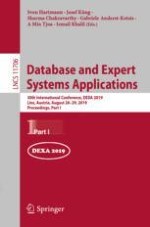This two volume set of LNCS 11706 and LNCS 11707 constitutes the refereed proceedings of the 30th International Conference on Database and Expert Systems Applications, DEXA 2019, held in Linz, Austria, in August 2019.
The 32 full papers presented together with 34 short papers were carefully reviewed and selected from 157 submissions. The papers are organized in the following topical sections:
Part I: Big data management and analytics; data structures and data management; management and processing of knowledge; authenticity, privacy, security and trust; consistency, integrity, quality of data; decision support systems; data mining and warehousing.
Part II: Distributed, parallel, P2P, grid and cloud databases; information retrieval; Semantic Web and ontologies; information processing; temporal, spatial, and high dimensional databases; knowledge discovery; web services.
